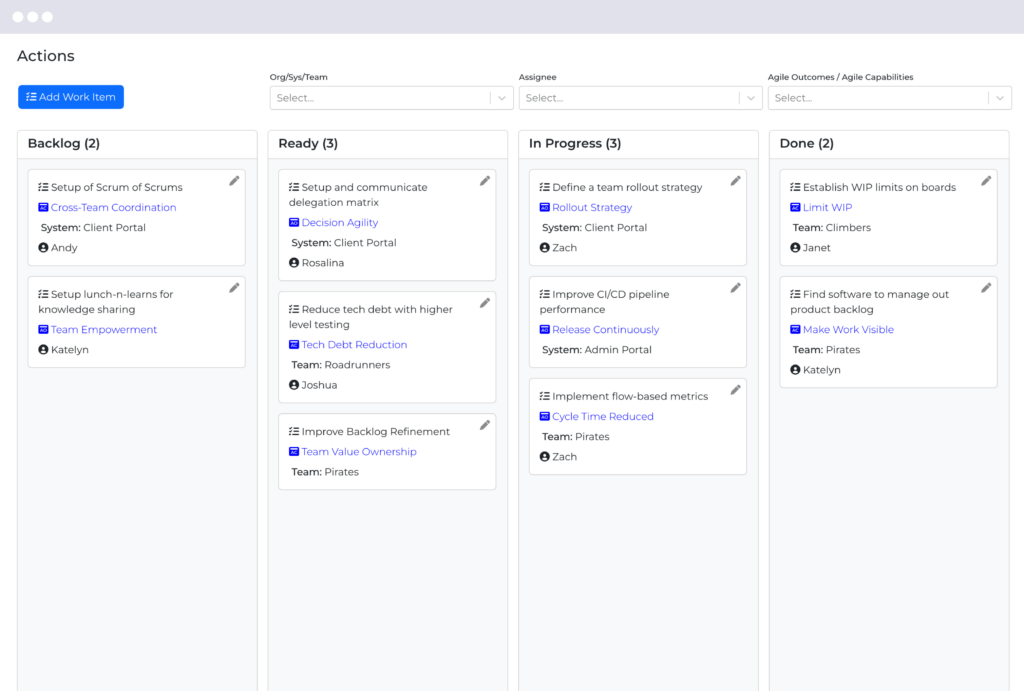
Client Overview
The client is a major financial services firm operating in a highly regulated environment. Its Information Security division is tasked with protecting the company’s digital assets, managing cybersecurity threats, and ensuring strict compliance with industry regulations.
The Challenge
The Problem
The Information Security team at a major financial institution was caught in a reactive cycle. They were constantly battling a flood of urgent operational incidents, compliance demands, and ad-hoc requests, leaving little room for critical strategic work. This “fire-fighting” mode meant that delivery timelines for key security initiatives were unpredictable and frequently missed. The lack of a clear system led to team burnout and made it impossible to provide leadership with reliable forecasts, eroding trust and hindering strategic planning.
The Root Cause
The core of the issue was the absence of a defined process for managing the flow of work. All tasks, from urgent security patches to long-term project milestones, were funneled into the same invisible queue. Without a way to visualize the total workload, classify different types of work, or protect planned initiatives from constant interruptions, the team had no mechanism to control their workflow. They were unable to manage demand, align work with their actual capacity, or prioritize effectively in their high-stakes, regulated environment.
The Solution

To move the team from a reactive to a predictable state, Agile Velocity helped them implement a holistic system based on core Lean and Agile practices. This new operating model was built on five key pillars:
- Visualizing Work: A Kanban system was implemented to make all work visible, including operational incidents, compliance-driven tasks, and strategic projects. This provided a clear, shared understanding of the team’s workload.
- Classifying Work Types: The team clearly distinguished between operational (urgent, non-deferrable) and project-based (strategic) work. This classification was key to preventing urgent tasks from constantly derailing planned initiatives.
- Establishing Regular Cadences: Daily stand-ups and retrospectives were introduced to help the team identify bottlenecks, surface dependencies, and continuously improve their workflow.
- Implementing Capacity-Based Planning: This practice allowed for realistic forecasting and ensured that the amount of work taken on was aligned with the team’s actual capabilities.
- Focusing on Capability Building: Through cross-training, shared ownership, and structured retrospectives, the team enhanced its technical skills and overall agility.
The Results
The new system delivered both immediate clarity and lasting, transformative change. By making work visible and creating structured processes, the team was able to move from a state of constant chaos to one of control and predictability.
Immediate Impact
The effect of the Kanban system was instantaneous. For the first time, the team and its leadership could see the true volume of work, exposing the hidden operational and compliance tasks that were derailing strategic projects. The daily stand-ups immediately improved communication, allowing the team to identify and swarm on blockers in near real-time. Within weeks, the practice of classifying work and planning based on actual capacity began to stabilize the workflow, putting the team back in control of their day-to-day priorities.
Long-Term Outcomes
Over time, these practices matured into a new, highly effective way of working. The most significant outcomes included:
- Improved Predictability and Trust: The team could now provide reliable forecasts for their strategic projects. This transparency and consistency rebuilt trust with leadership and allowed for better alignment with business goals.
- Enhanced Team Capability and Empowerment: With stable processes in place, the team shifted its focus to continuous improvement. Through cross-training and shared ownership, they increased their collective skills and became more resilient. The team was empowered to own their workflow and solve problems proactively.
- A Sustainable Balance: The team successfully broke the cycle of constant fire-fighting. They achieved a sustainable equilibrium, allowing them to handle urgent operational demands efficiently without sacrificing progress on high-value strategic initiatives, all while improving their compliance and security posture.
Ultimately, the engagement transformed the Information Security team from a reactive, overburdened cost center into a predictable and strategic partner to the business. With a clear, sustainable system for managing their workflow, they can now effectively protect the institution from immediate threats, ensure regulatory compliance, and deliver on the long-term security initiatives that drive the business forward. They are no longer just managing risk; they are enabling business strategy.
Ready to Move Beyond Fire-Fighting?
If your team is caught in a reactive cycle, our experts can help you implement the systems to create predictable flow and unlock strategic value. Schedule a no-obligation consultation with our team to discuss your unique challenges.


